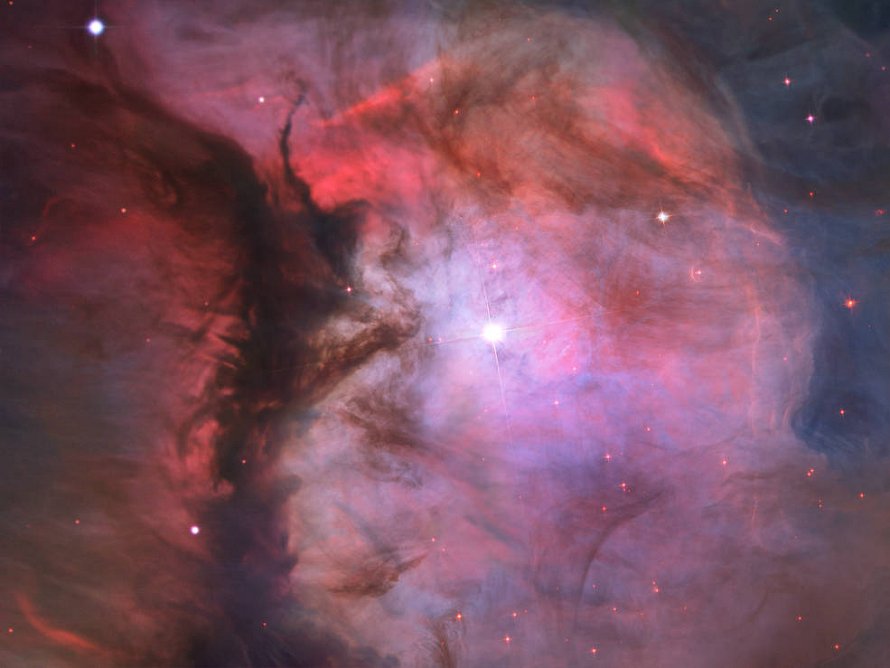M43 (NGC 1982) - De Mairan's Nebula
Messier 43 (NGC 1982), also known as the De Mairan's Nebula, is a diffuse nebula located in the constellation Orion, in the Orion Arm of the Milky Way Galaxy in the Local Group of galaxies. M43 is 1300 light years away from Earth.
M43 is best viewed during winter, is magnitude 9, and can be viewed with binoculars. M43 is 20' x 15' in apparent size. For reference, the full moon is 30'.
Observing difficulty: Intermediate
- Name:
- De Mairan's Nebula
- Type:
- diffuse nebula
- Constellation:
- Orion
- NGC or IC:
- NGC 1982
- Magnitude:
- 9
- Viewing:
- binoculars
- Size:
- 20' x 15'
- Distance (light years):
- 1300 LY
- RA:
- 5h 35.5m
- Dec:
- -5 16'
- Season:
- winter
- Milky Way location:
- Orion Arm
- Galaxy group:
- Local Group
- Messier Marathon #:
- 14
* The naked eye can see up to magnitude ~7-8 objects under ideal dark sky conditions.
Delving into the De Mairan's Nebula
Messier 43 (M43), also known as De Mairan's Nebula, is an emission nebula in the constellation Orion. It is part of the Orion Complex and is considered an extension of the Orion Nebula (M42), separated by a dark lane of dust. This article explores the historical context, physical characteristics, and astronomical significance of M43, along with the ease of locating and observing this object from Earth.
Historical Overview
De Mairan, a French astronomer, first observed M43 in 1731, distinguishing it as separate from the Orion Nebula due to the dark dust lane. This designation resulted in the alternative name, De Mairan's Nebula. Charles Messier later added it to his catalog as Messier 43 in 1769. Despite its close association with M42, M43 has distinct features and characteristics that make it a fascinating object in its own right.
Physical Properties and Magnitude
M43 spans about 20 arcminutes, translating to a physical size of roughly 6 light-years, and is located at a distance of about 1,600 light-years from Earth. It is considered a separate region of the much larger Orion Nebula complex and is classified as a H II region, indicating the presence of ionized atomic hydrogen.
The nebula's illumination comes predominantly from a single star, NU Orionis, a variable star that is much hotter and more massive than our Sun. The apparent magnitude of M43 is around 9, making it considerably fainter than the Orion Nebula, but still observable under dark skies with medium-sized telescopes.
Astronomical Significance
M43 provides an excellent study in contrast with the Orion Nebula. While M42 is illuminated by a cluster of stars (the Trapezium), M43 is primarily illuminated by a single star, NU Orionis. This allows astronomers to observe and study the interaction of a single hot star with the surrounding nebula.
Finding and Observing M43
Locating M43 is relatively straightforward due to its close proximity to the Orion Nebula, one of the most recognizable objects in the night sky. Found in the constellation Orion, it is nestled below Orion's Belt in the Sword of Orion.
To the naked eye, M43 is generally indistinguishable from the larger and brighter M42. However, with a small telescope or even a pair of binoculars, the two nebulae can be distinguished, especially from a dark sky location. M43 appears as a small patch of light detached from the main body of the Orion Nebula. Due to its faintness, viewing M43 requires a clear, dark night, away from significant light pollution.



